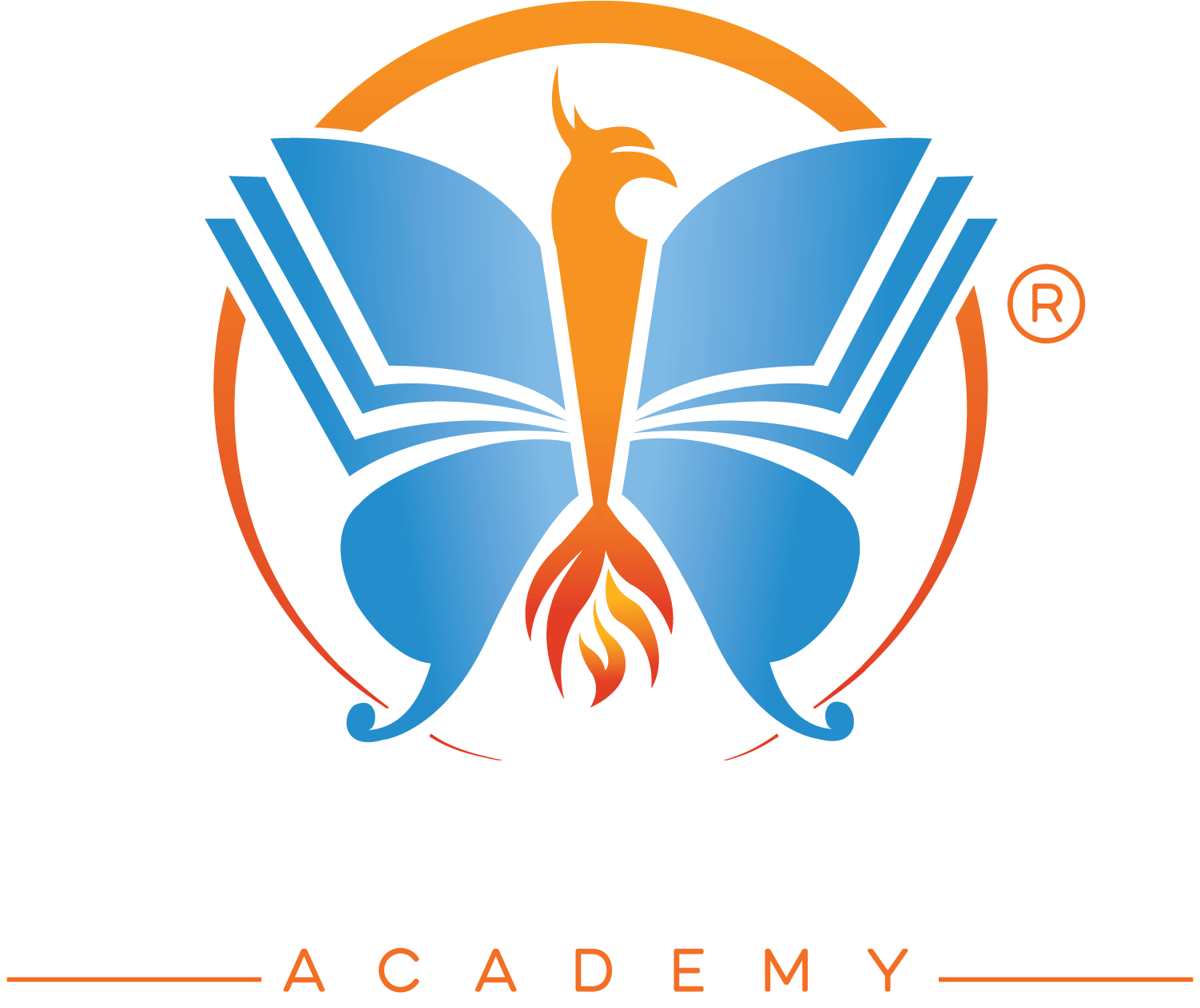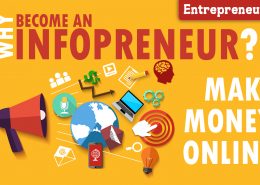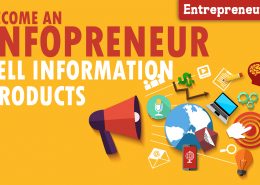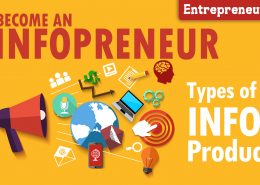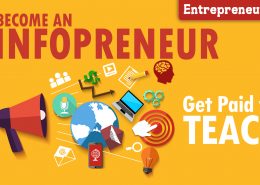So, how do you know which type of information product is right for you?
It depends on a number of factors. You may want to come back and answer these questions AFTER reviewing the different types of information products (below).
- What are you teaching?
- What delivery methods do you feel would work for you?
- What’s your personality like and what you like to do with your day? Do you like writing, talking, teaching, working one-on-one, speaking, creating?
- What types of information products make sense for your market or industry?
- What are other people in your field doing successfully?
Top 10 Types of Information Products
This list of information products is organized into the same 3 categories of delivery that we discussed when looking at how to package your knowledge.
Circle the info products that sound interesting to you.
WRITING:
1) Writing and eBooks
eBooks or Mini-guides: eBooks are simply digital versions of books. Writing a full book is certainly an option, and with self-publishing sites like CreateSpace you can just as easily create a physical book that goes along with your eBook and is printed “on-demand” (meaning someone orders it on Amazon.com, it’s printed and shipped, and you don’t have to touch it). However, today many (if not most) eBooks are not full books. They are more like mini-guides or short books about specialized topics. In the information age, readers are eager to get to the point and have access to information at their fingertips. Therefore, short, focused eBooks can do very well and make up a LARGE PORTION of all information products on the market.
eBooks can be sold through channels such as Amazon, but they can also be sold directly through your own web site or blog. Rather than people searching a broad warehouse of information and coming across your eBook, they find your site or blog through targeted searching and buy your eBook because it’s specifically relevant to them.
eBooks are often used as an “entry level product” (see Funnels and Tiers) because they’re a good way for a customer to get quick access to your knowledge and get to know you. Then, higher level information products can be offered to customers who are eager to learn more. However, for some infopreneurs their eBook is their main focus. In fact, many infopreneurs publish a large number of eBooks and create entire businesses around it.
eBooks are great if you have a LOT of information to share. They can also work well as “how to” guides in-which you’re teaching the foundation of your skill or process. Below are 4 approaches to creating eBooks:
- Targeting: Who or what can you target easily because there is a need and you have the information to fulfill the need?
- Add-On: Do you have any other products or services you could either add on to or create an ebook from?
- Series: Do you have any information that could be taught in a series? Could you write an eBook and then follow up with sequels?
Articles and white papers: A white paper is ultimately an article that’s more specifically for a certain industry or business. Writing articles is a good way to begin to compile your knowledge. Rather than trying to write an entire book, you can write one small section at a time by picking an important sub-topic and writing an article about it. You can publish articles on your own site (through a blog) or submit them to newspapers, magazines, other blogs or websites that focus on articles or your niche. In some cases you can be paid for your articles. In most cases, publishing articles in other places acts as a way of reaching more people, increasing your credibility, and possibly gaining clients who are interested in taking it further.
Templates and forms: If what you are teaching is a process or information that would benefit from having made-for-you templates and forms that customers could download and use in their job, hobby, business, etc, then creating and offering these is a great entry-level product. You can offer them for free (as a giveaway in exchange for a website visitor’s email) or for a small fee. They can be included in eBooks. They can also be created and included as part of a larger program, such as an online course.
2) Audiobook
In most cases, an audiobook would be a verbal recording of material from an eBook or book. You can also take the audio from a recording of a live event, a video program, an interview, or a webinar or teleseminar and turn it into an audiobook or audio program. Like other information products, you can sell audiobooks through your own website (as digital downloads or physical CD products) or you can sell them through websites specifically for audiobooks.
3) Blogging
Blogs are information-based websites. The objective of a blog is to take your knowledge and skill and create a resource online that draws people who are looking to learn what you have to teach. You want your blog to be the best one-stop-shop for information and/resources on your topic (in your niche). This makes you an authority. Blogs consist of many articles, informational posts and other information and they are successful if they focus on a specific topic. Blogs are keyword friendly and can generate good traffic from search engines. In order to have a blog generate revenue, you must a) have an audience (get people to your site) and b) have products or services to sell.
Your blog should provide tremendous value for free. Share transformational information and offer powerful resources. You can then offer higher-level products or knowledge for a fee, whether it’s a product your audience needs or more detailed information product, such as an eBook, webinar, online course, etc. Your blog can also become a location to grow community in your niche (although this is best only after you have a lot of engaged traffic, as a forum with no comments is not effective).
You don’t have to be the only contributor. Are there experts or leaders in your field or others who could contribute articles? Whom you could interview? Who have a product or service they could sell your site visitors (as an affiliate)? Are there other resources your visitors would be interested in? If so, compile a list of recommended resources. Saving them time by doing the research and selecting the BEST will make them appreciate your site and likely come back for more.
Add content regularly (even daily). This is why you will want to find other sources of information or contributors. It can be a lot to product content that regularly all by yourself. You can also included VIDEO in your blog. In fact, you can have Vlog (video blog) that is all video. Videos can be embedded easily into your blog. You can also have a video-only vlog through YouTube (or others). More on that later.
TRAINING:
4) YouTube Videos
Ok, so YouTube videos don’t specifically have to be training videos, although they can be. They can also be straight information (such as the same content in your eBooks, articles or blog). In fact they can BE a blog (vlog).
TRAFFIC AND FOLLOWERS: Creating educational YouTube videos on a regular basis on a particular topic can help you grow an audience. From these videos you can get traffic to your blog, site, or product by including information and links in the video description, or even creating a call to action and link within the video. As mentioned, you can have a video blog in which you regularly share information, ideas, thoughts, or tools through video posts. Viewers who like your content will “follow” you. The regularity of your blog is key, as it keeps viewers coming back. The more they watch and like you, the more likely they are to buy from you.
MAKING MONEY: You can make money through YouTube videos two ways. The first is to sell a product or service. The second is to have ads that run during your videos, which you make a small amount per view.
TEACHING: Videos can be created teaching a series of information that is specifically designed to leave audiences wanting more. At the end of the series you can make an offer for a program or product that will provide more detailed, higher value information to those who made it through the series. These videos can be on YouTube or you can create a web page for them.
5) Webinar or TeleConference
Teleconferencing: Teleconferences or teleseminars are live audio events, usually between 60 and 90 minutes, that focus on providing information on a particular topic. You host an event in which you share or teach and participants join by calling in to listen through their own phone or through the website of the teleconference where they can listen online. Depending on the program you use, participants can engage with you by talking live to ask questions or be interviewed. There is often also an online dashboard where listeners can make comments in a chat window. Teleconference programs give the ability to mute listeners and for them to “raise their hand” through pushing a button on their phone or computer. The level of interactivity is completely up to you, as the host. Many teleseminars are informational only, meaning the teacher teaches and the attendees listen.
You can teach an entire long-term program through teleconferences. You can also use it as a one-time event, an introductory program designed to invite attendees to join your larger program, etc. They can be recorded and the audio can be re-used later for another pre-recorded teleseminar or for an audio program.
Webinars: Webinars are ultimately video-based teleseminars. They operate similarly to teleconferencing, however participants can see video in addition to hearing the instructor. In many cased, participants have the ability to join by phone as well, in which case they cannot see the video but they can hear the audio. Many webinar platforms have an app, in which case users can download the app (or view the webinar through the internet) and therefore access both audio and video through their smartphones. Webinars have the ability to show the video of the instructor as well as the option to either show a slide-show presentation or share the computer screen of the instructor. All options are at the discretion of the instructor and are controlled through an instructor dashboard interface.
Other Videoconferencing: There are variety of other online videoconferencing services such as Google Hangouts, Periscope, Blab and Facebook. These technologies allow you to go “live” and teach your audience for free. You can explore resources in that section to see if any of these programs will be helpful to you. The main take away is that if you want to be able to connect to your audience, there are a multitude of ways to get in front of them and provide value, at no cost to you.
***Quick note about why virtual events are often the best place to start…
- You get to help your audience get to know you and see you as an expert.
- You can start small, get comfortable and learn as you go.
- You can present your full curriculum in pieces and create it as you go (so you can start quickly) rather than waiting until it’s 100% complete.
- You get to test our EVERYTHING to see what works and get comfortable doing video and using the technology.
- You get to practice your timing to see how long it actually takes to present your content.
- You can do Q&A’s which help you learn what your audience REALLY wants and adjust your program the next time.
- You have to create the material, worksheets, etc, which you can use again later.
- You can record it and the re-package it and turn it into other information products.
6) Seminar and Workshop (in-person)
Informational Seminars: A seminar is a presentation in which you’re providing or teaching information to an audience who is interested in your topic. You can conduct seminars to organizations, at conferences, to non-profits, or you can host them on your own. Seminars are like in-person webinars. They tend to be on a specific topic and you can go into great detail if your focus is narrow. Seminars are a great way for the audience to get to know you and get familiar with what you have to offer. Many infopreneurs do free seminars as a form of marketing, although in some cases you can get paid as a guest speaker.
Interactive Workshops or Trainings: The difference between a seminar and a workshop is that the latter is more interactive. In workshops, the audience plays an active role, engaging with the presenter, answering questions, and even working in small groups or doing independent activities or completing workbook material. Workshops are focused more on training and teaching rather than simply sharing information and knowledge. Workshops are typically longer (90 minutes to full days) and much more in-dept. A workshop is more like an online course, while a seminar is more like a webinar. Workshops usually have a registration fee for participants. If hired to conduct a workshop for an organization, you’re usually paid a flat fee and it’s considered a training.
Selling from the Stage: When speaking or presenting at a seminar, conference or other speaking engagement, you can design your presentation to share your knowledge, skill or process, while also making an offer at the end of your presentation that invites the audience to join you for your program or buy your product. When selling from the stage, it’s important to provide tremendous value, which creates a desire within attendees to know more. We have a whole course designed to help you create such a presentation (Be a Client Magnet with Workshops). Having a specially designed presentation that helps you get clients or sell products makes those free speaking engagements or seminars we mentioned above worth your time. You can also use this strategy when delivering introductory teleseminars and webinars.
7) Online Course
Online Courses: Online courses are great for teaching in-depth knowledge on a particular topic. They are ultimately virtual versions of a workshop. If your material would take you 1 hour or more to teach, an online course may be a good fit. Many courses are 4 to 8 hours long. Online courses allow you to teach directly to your students through video. Unlike a webinar, an online course is not taught live in most cases. The videos are either pre-recorded or a previous long-term webinar program can be re-used to create an online course. Courses often also include workbook material that students can download, print and complete.
Courses can be self-paced, meaning students are given access to the entire program and they can complete the lessons and modules as quickly or slowly as fits their schedule. Courses can also be unlocked over time through an email drip sequence, such as releasing a new lesson and activity weekly on Wednesday. When using a drip sequence, students an begin the course when they register and complete over X number of weeks. Alternatively, you an hold a “class” in which all students start the program at the same time. This group-program will be discussed more below.
The online course has replaced what was once referred to as a “home study system,” including a manual or binder and CD’s or DVD’s. Now the material is available through internet access on the computer, however the benefit of learning in the comfort of one’s home remains the same.
Training Program: A training program takes a course to a higher level by teaching a skill or process that is more in-depth. Training programs can also confer certifications upon completion, recognizing participants for having completed extensive training in a particular area. Training programs are also common in the corporate, where you may be hired by a company to train a team or employees. Trainings can be conducted in person or virtually through an online course. They can be taught to groups, in person or thorough group programs (below) or to an individual who enrolls in an online course and completes the program independently.
8) Membership Program
Membership programs are great for developing ongoing relationships and for sharing large amounts of knowledge. Other information products, such as articles, blogs, webinars, videos, courses, etc can be included in your membership program. Membership websites often provide high-value, free content to site visitors, however to access the full-array of higher level content, the visitor must sign up to be a member. Memberships can be free, as a way to build a relationship, get your site visitor’s email address to grow your list. Over time, you can upsell members to other products and services. You can also charge a membership fee, usually monthly or annually. The more high-value, exclusive content you offer through your membership site, the more likely and more money your members will be willing to pay. The key to memberships is either to:
- give members access to materials that would otherwise cost them a much larger sum of money
- give members access to exclusive information that they cannot access easily any other way
- give members access to organized, assessable information that saves them time (this material may be available elsewhere, but you provide them a shortcut)
COACHING:
9) Coaching or Consulting
Coaching/consulting is in-and-of-itself its own service business. As we mentioned before, consultants provide expert advise while coaches provide accountability and tools for achieving desired goals and outcomes.
Coaching/consulting makes an excellent capstone, high-end service to offer at the top of your information product pyramid (or the bottom of your funnel). Information products can be used to draw in targeted customers. They can be used as entry-level products and mid-level programs, and then, after consuming your information products, the clients who wish to take it EVEN FURTHER can hire you as a coach or consultant. Alternatively, if you are a coach or consultant, you could create information products to sell your clients. In these products you can teach them additional tools and information that go beyond what you cover in your coaching or consulting sessions. Information products and coaching/consulting are the perfect complementary pair.
One of the keys to this type of business model is that the more of your time or the closer access that someone is getting to you, the more they pay for it. This is why in most cases one-on-one coaching with you is the most expensive offering you have.
10) Group Program
Group program are trainings, courses or coaching/consulting that you conduct with a small group of people at the same time. In group programs, you’re teaching you best, most high-valued material. The benefit of teaching to a group is that you can reach more people in the same amount of time. Just like speaking at seminars and workshops, rather than coaching or training 1 person for many hours, you can coach 10 or 20 or 50 or more people in that same amount of time.
Usually, the fee to participate in a group program is less than you wuld charge to teach the same content one-on-one, which makes your knowledge more affordable and accessible to more people. The benefit to you is that 30 people at $300 is a lot more than 1 person at $1,000, even though they’re ultimately receiving a 70% discount.
In most cases, group coaching or training programs happen over X number of weeks, much like an online course that is accessed through a drip sequence. A group program can include the same material taught through an online course. The difference would be that students would, in addition to the course material, participate in other program features, such as live Q&A teleconferences, webinars, forum discussions, group work, and/or coaching with you. You can also package group programs with other information products or in-person events.
Common types of group programs:
- Bootcamp or Training: Usually a 4 to 10 week program designed to teach a skill, teach a program, or provide structure for participants to work on achieving a desired outcome.
- Masterminds: A highly-engaged small group with works collaboratively while completing a program designed to teach them a skill or process OR a program designed to coach the group to achieve individually designated goals and provide networking and support from within the group. Mastermind groups can be 6 weeks to a year.
- Corporate Training: Teaching or training conducted to a group of employees, managers or a team in a corporate environment.
Your Thoughts on Information Products
Which information products listed above are interesting to you?
Which could you make easily and quickly?
Which one (or two) do you feel are the most important for you?
Which one would you like to create first?
INFOPRENEUR
Article & Video Series
Click below to view additional blogs in the series. SCROLL RIGHT >>>
